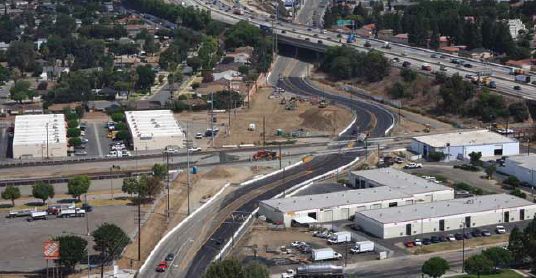Project News
Full Steam Ahead at Placentia Avenue Grade Separation Project

Crews have begun work on the $24 million Placentia Avenue Grade Separation project on the border of the cities of Fullerton and Placentia, Calif. The Orange County Transportation Authority project includes construction of a crossing for the Burlington North Santa Fe rail line over Placentia Avenue. The new two-span precast girder crossing will be approximately 100 feet long and 50 feet wide, built on 24-inch cast-in-drilled-hole piles. The bridge and rail tracks will remain at grade, and the new road will be lowered below grade, passing under the overcrossing.
Freight trains whiz by every 24 minutes and the grade separation allows vehicles and pedestrians to travel along Placentia without waving to wait for a train. BNSF anticipates a 45 percent increase in rail traffic on the line by 2030. There are six other contracts for similar work—some overpasses, and some underpasses—along the rail line in Orange County.
“These freight trains can be over a mile long and when they come through, everything stops,” explained project manager Lenny Gardino.
So far, crews have detoured vehicle traffic and are in the process of completing a temporary bypass called a shoo-fly that will divert train traffic around the construction site. Once the shoo-fly is complete, crews will install shoring and start excavation for the new crossing. Construction will also include building retaining walls and a pump station, street improvements, storm drain, sewer, water, and lighting improvements. Flatiron is not responsible for track work, which will be completed by BNSF. The project will be complete in mid-2014.
Lenny, who has been with Flatiron for seven years, says that while the majority of the work is pretty typical, the job is anything but. “This is one of the most difficult jobs I’ve been on,” said Lenny. “There are lots of different agencies to coordinate with and we have limited access to the area. Plus, it’s an older city, so we keep finding utilities and other unexpected things—there are a lot of unknowns.”
The proximity of the tracks adds an additional layer of complexity.
“Safety is a priority. This is a busy area, so we’ve got to keep an eye on pedestrians,” said Lenny. “We also are working on and near active railroad tracks. We have a flagger there at all times, but these trains are huge, and we get up to 60 trains a day on these tracks. And it’s not just freight, but also Metrolink, Amtrak and commuter trains, which travel at high speeds.”
Shoring on the project is also challenging. It requires deep excavation, but because of limited space and adjacent private property, crews can’t use tiebacks. Instead they’ll install shoring up to the property line.
As the work ramps up and bridge construction begins, about 25 people will make up the project team. Employees from different projects are already showing up, which is part of the fun for Lenny. “My favorite part so far is working with a whole different group of people. I’ve been working in San Diego, so this is a different team for me. It’s been great.”
